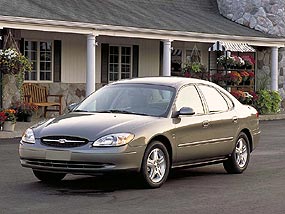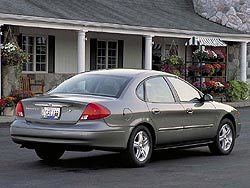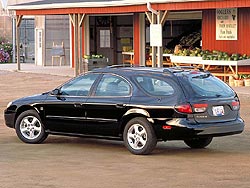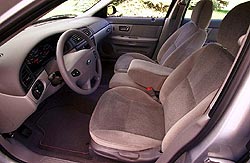|
August 4, 2005
Used
Vehicle Review:
Ford Taurus, 1996-2005
By Chris Chase

2002 Ford Taurus SEL. Click image to enlarge |
Not everyone's perfect.
And certainly not every auto manufacturer is either. After all,
if they were, the world would be a pretty boring place, so in
that sense, it's a really good thing the Ford Taurus exists
.
The Taurus has been a
strong seller in the mid-size sedan field, competing against the
likes of class benchmarks like the Toyota Camry and Honda
Accord. You have to wonder why, though. Maybe buyers found the
Taurus to be competitively priced, and others may have liked the
idea of a domestic car, built by North Americans. Or maybe it's
the bland styling that's drawn thousands upon thousands to Ford
dealerships over the years to buy one of these simple but
uninspiring cars. Whatever the case, it certainly wasn't the
Taurus' reliability history that kept buyers coming, but I'll
get to that later.
In 1996, Ford managed to
create a Taurus that did inspire - inspire strong opinions about
its looks, that is. That was the year Ford took the Taurus'
familiar shape and turned it into something that looked as
though it had been left out in the sun to melt. The car was
basically one big oval: oval headlights, oval taillights... even
the radio and climate controls inhabited a big oval in the
centre of the dashboard.
The new shape was an
experiment on Ford's part to see if it could set its mainstream
family car apart from the crowd. Unfortunately, it didn't work
and Taurus sales reflected that when the Camry became the best
selling car in North America, a title the Taurus had held for
many years.
"Operation: Oval" lasted
until 1999, and 2000 saw the launch of "Operation: Are We Ever
In Trouble" and the introduction of a heavily face-lifted Taurus
with looks much better suited to the expectations of mid-size
sedan customers. The oval head- and taillights were scrapped for
more traditional looking ones, and the radio and HVAC controls
got a new home in a more conventional looking dashboard.
Truth be told, the
Taurus offered something that its import competitors didn't for
most of the years between 1996 and 2005: a station wagon body
style. The Accord wagon disappeared before Ford entered its oval
phase and 1996 was the final year for the Camry wagon. That left
the Taurus wagon pretty much on its own in the class as an
alternative to minivans and the SUVs that were gaining
popularity by the mid-1990s.
The Taurus was
available with one of two engines during this 10-year period.
Basic models got the wheezy 3.0 litre Vulcan V6 that powered
everything from Aerostars to Ranger pick-up trucks and dated
back to the original 1986 Taurus. In models from 1996 through
1999, it produced an asthmatic 145 horsepower. In 2000, the
Vulcan got a small horsepower boost to 153. How it managed to
survive right up until the 2005 model year - when most of the
Taurus' four-cylinder competitors had more power - is a mystery.
The preferable Taurus
engine choice was also a 3.0 litre, but in this case the more
modern twin cam Duratech, which produced a far more
class-competitive 200 horsepower.
With either engine,
fuel economy is about the same: around 12 L/100 km in city
driving and about 8 L/100 km on the highway, which is
competitive with V6-equipped Accords and Camrys (four-cylinder
models of those cars are better on gas but don't have as much
low-end grunt as the Ford's Vulcan V6).

2002 Ford Taurus SEL. Click image to enlarge

2002 Ford Taurus SE wagon. Click image to enlarge

2001 Ford Taurus SEL. Click image to enlarge |
U.S. National Highway
Traffic Safety Administration crash test results show the Taurus
to hold up fairly well in collisions. Early models (1996-1998)
scored four stars each for driver and front passenger protection
in frontal impacts, and three stars each for front and rear seat
occupant protection in side impacts. In 1999, the Taurus' side
impact scores remained the same, but its frontal impact rating
increased to five stars each for driver and front passenger
protection. Finally, 2004 and 2005 versions earned four stars
for the driver and five for the front passenger in frontal
impacts. Once again, it earned double threes in side impact
protection.
It's worth noting that
while side airbags were optional on Tauruses starting in 2000,
their presence or absence doesn't affect NHTSA crash test
scores. ABS was an option until 1999, and became standard
equipment on all but base models starting in 2000.
On reliability: as I
mentioned above, the Taurus is not known for its long-term
durability, a sentiment reflected in Consumer Reports' opinion
of it. The magazine gives it an average rating across the board
but cites many trouble spots ranging from faulty transmissions
(especially in older models), a wonky fuel delivery system, and
electrical, brake and suspension issues. The Taurus was subject
to well over 20 recalls during this 10-year timeframe, so it
would be worth making sure any that apply to a prospective
purchase have been addressed.
The Taurus'
troublesome nature is tempered somewhat by abysmal resale values
that are typical of domestic cars. Take a 2004 Taurus SEL
Premium station wagon: Canadian Red Book values it at $17,500
today, or 56 per cent of its M.S.R.P. and a depressing prospect
for anyone stuck with one they bought new. If you're interested
in a used Taurus, look for a 2003 or newer model with some of
the original warranty left to spare yourself expensive repairs,
at least in the short term. Canadian Red Book values 2003 models
from just under $14,000 to a little over $15,000.
It's safe enough to
say that a used Taurus isn't the best choice out there. While
its low price and availability as a station wagon can make one
seem like an attractive alternative to more expensive import
models, the Taurus' poor reliability history make it a used car
that's best avoided. If dependability is a primary concern (how
could it not be?), a slightly older Accord or Camry - or even a
Nissan Altima - would be a far wiser choice.
Pricing
Red Book Pricing (avg.
retail) August 2005:
| Year |
Model |
Price
today |
Price new |
| 2005 |
SEL sedan |
$19,150 |
$28,595 |
| 2004 |
SEL sedan |
$16,425 |
$28,440 |
| 2003 |
SEL sedan |
$14,175 |
$28,090 |
| 2002 |
SEL sedan |
$11,550 |
$27,520 |
| 2001 |
SEL sedan |
$9,900 |
$27,020 |
| 2000 |
SEL sedan |
$7,475 |
$26,495 |
| 1999 |
SE sedan |
$5,650 |
$24,195 |
| 1998 |
SE sedan |
$4,425 |
$23,996 |
| 1997 |
LX sedan |
$3,625 |
$26,195 |
| 1996 |
LX sedan |
$3,225 |
$26,555 |
On-line resources
www.fordforums.com -
The Taurus is hardly a car that inspires a lot of enthusiasm
among owners, so it's no surprise that there isn't much out
there in terms of Taurus enthusiast web sites. The closest thing
you'll likely find is this site, which covers all Ford models.
The Taurus is represented with a section dedicated to it and its
Mercury Sable sibling, but there's not a lot of action there.
www.ford-forums.com - But wait! There is another website with a
place for Taurus owners to commiserate. This, like the
non-hyphenated site above, covers all Ford models and has a
section dedicated to the Taurus, but don't get your hopes up:
this one's pretty quiet too.
Recalls
Transport Canada
Recall Number: 1996084 Units affected: 6,307
1996: For vehicles equipped with ford AX4S automatic transaxles:
the park pawl shaft may have been improperly positioned during
transmission assembly. This could result in the park pawl not
engaging when the transmission selector is placed in the park
position. This could allow the vehicle to roll as if in neutral
if the vehicle operator does not apply the parking brake.
Correction: vehicles will be inspected and if necessary the park
pawl shaft roll pin and park pawl shaft will be replaced.
Transport Canada
Recall Number: 1996034 Units affected: 4,960
1996: These vehicles may not comply with C.M.V.S.S. 105 -
hydraulic brake systems. The brake system fluid level indicator
may malfunction which could cause the brake system warning lamp
to: (1) remain illuminated continuously, or (2) fail to
illuminate as intended should the fluid level fall to a certain
level. Correction: brake system fluid level indicator lamp
switches will be replaced on affected vehicles.
Transport Canada
Recall Number: 1996148 Units affected: 17,222
1996: The automatic transaxle park mechanism may not prevent the
vehicle from rolling even if the transaxle shift lever is firmly
placed in the "park" position. If the driver is unaware that the
park mechanism of the transaxle has not properly engaged and
leaves the vehicle unattended without setting the parking brake,
the vehicle could be free to roll as if in neutral. This could
result in a crash without prior warning. Correction: park
mechanism will be inspected and, if necessary, a new park pawl
shaft will be installed in the transaxle.
Transport Canada
Recall Number: 1998114 Units affected: 18
1996: Vehicles that were serviced for a stall condition between
August 1, 1997 and December 1, 1997 may have received an
incorrect fuel tank. The incorrect tank contains an additional
vent hole which provides the potential for a fuel leak.
Correction: vehicles will be inspected and fuel tank will be
replaced with the correct tank if necessary.
Transport Canada
Recall Number: 1996135 Units affected: 2,391
1996-1997: The park pawl abutment bracket has a sharp edge which
may cause the parking pawl to hang up and not engage the park
gear. This may cause the vehicle to move even though the gear
shift indicator shows that the vehicle is in park. As a result,
unintended and unexpected vehicle movement could occur with the
possibility of personal injury and property damage. Correction:
dealers will inspect and, if necessary, replace the park pawl
abutment bracket on affected vehicles.
Transport Canada
Recall Number: 1997047 Units affected: 36
1996: Note: flexible fuel vehicles. A seal for the fuel delivery
module wiring harness connector may swell in the presence of
unleaded fuel and force the connector apart creating an open
circuit. This would result in loss of fuel pump operation and
fuel pressure. In addition, the vapour control valves, located
on the fuel tank may not operate properly resulting in vapour
emissions in excess of the standard. Correction: wiring
connector seal and fuel tank vapour vent valve assembly will be
replaced.
Transport Canada
Recall Number: 1996124 Units affected: 209
1996: The fuel pressure regulator diaphragm may rupture. Should
this occur, engine damage or fuel leakage could result. Fuel
leakage in the presence of an ignition source could potentially
result in a fire. Correction: vehicles will be inspected and
fuel pressure regulators will be replaced where required.
Transport Canada
Recall Number: 1997124 Units affected: 10,607
1997: note: vehicles equipped with the AX4S automatic transaxle.
These transaxles are equipped with low/intermediate servo covers
that can separate from the transaxle while the vehicle is being
driven. If this occurs, the transmission fluid will be expelled
and can contact the catalytic converter. This can result in a
vehicle fire. Correction: servo cover will be replaced on
affected vehicles.
Transport Canada
Recall Number: 1998050 Units affected: 45,205
1997-1998: these vehicles do not comply with C.M.V.S.S. 108 -
lighting system and retro-reflective devices. The headlight
aiming instructions provided in the owner guides are not
sufficiently clear. Correction: revised owner guides will be
mailed to owners.
Transport Canada
Recall Number: 1998173 Units affected: 308
1998-1999: These vehicles may have a front seat belt buckle
attaching stud that may have been improperly heat treated. This
heat treating may have resulted in cracks developing in the
stud. If the stud is cracked, there is the potential for less
than the intended level of occupant restraint in the event of a
vehicle crash. Correction: seat belt buckle mounting bracket and
stud assembly will be replaced on affected vehicles.
Transport Canada
Recall Number: 1998182 Units affected: 32
1999: The dash insulator retainer may not have been fully
engaged. The retainer may disengage, and in some cases it could
become lodged above the accelerator pedal pivot. This could
prevent the engine from fully returning to idle. Correction:
vehicles will be inspected for proper installation of the dash
insulator retainer and re-install if required.
Transport Canada
Recall Number: 1999176 Units affected: 1,889
1999: On certain vehicles, the seat belt retractor in certain
seating positions may have a pin shaft in the switchable ELR/ALR(emergency
locking retractor/automatic locking retractor) mechanism that is
incorrectly formed. In some circumstances, the switching
mechanism could become non-functional, which could prevent the
seat belt webbing from being extracted from the retractor.
Correction: Affected vehicles will be inspected and suspect lap
and shoulder belt assemblies will be replaced.
Transport Canada
Recall Number: 2004252 Units affected: 59,758
1999-2001: On certain vehicles, the front coil springs may
fracture when operated in high corrosion areas (where salt is
used on the roadways in winter). The potential for corrosion
causing a spring to fracture increases with the number of
kilometres and years in service on the vehicle. A fractured
spring could move past the spring seat and contact a front tire
causing a rupture resulting in a rapid air loss. Correction: For
vehicles sold in or are currently registered in the provinces of
Ontario, Quebec, New Brunswick, Prince Edward Island, Nova
Scotia, Newfoundland and Labrador, dealers will install
protective spring shields as specified in recall campaign 04S17.
In addition, Ford will notify nationwide all 1999 to 2001 Taurus
and Sable owners of a Customer Satisfaction Program 04M04 in
which Ford will provide additional repair coverage for
replacement of fractured front coil springs for a period of 10
years from the original date of sale of the vehicle, or up to
240,000 kilometres, whichever occurs first.
Transport Canada
Recall Number: 2001044 Units affected: 3,853
2000-2001: Certain vehicles equipped with deck lid mounted rear
spoilers do not comply with the requirements of CMVSS 108 -
Lighting System and Retroreflective Devices. With the ignition
key in the run or start positions, and the hazard lights turned
on, the spoiler mounted centre high mounted stop lamp is
activated at a reduced intensity without depressing the brake
pedal. In addition, under these same circumstances, the
brake-shift interlock can be circumvented. Correction: Dealers
will install a jumper/resistor assembly at the spoiler.
Transport Canada
Recall Number: 2001067 Units affected: 23,561
2000-2001: On certain vehicles, the adjustable pedal assembly
may have excess grease that could potentially enter the stop
lamp switch and contaminate the contacts. This could lead to a
build up of carbon, and potentially a short circuit. A short
circuit could either cause the stop lamps to remain on, or cause
a loss of stop lamp function. Correction: Brake lamp switch will
be replaced and excess grease will be wiped off the adjustable
pedal assembly.
Transport Canada
Recall Number: 2001068 Units affected: 5,235
2000: On certain vehicles, the headlamp switch knob may have
been moulded from a plastic material that is more brittle than
the intended material. This material may be overstressed when
the knob is installed on the switch, leading to a later
fracture, and in some cases, separation of the knob from the
headlamp switch. If this should occur, it may be difficult for
the driver to activate the headlamps. Correction: Headlamp
switch knob will be replaced with one made of the intended
material.
Transport Canada
Recall Number: 2001204 Units affected: 83,005
2000-2001: Certain passenger cars, sport utility vehicles, and
light and medium duty pickup trucks. A switch located in the
plastic cover of the wiper motor gear case could malfunction and
overheat, potentially resulting in loss of intermittent wiper
function, loss of wiper park function, complete loss of wiper
function, smoke or, potentially, ignition of the plastic cover
material. Switch malfunction is most likely to occur when the
intermittent setting of the wipers is being used, or when snow
or ice obstructs the blades from returning to the "parked"
position at the bottom of the windshield. Loss of visibility
while driving increases the risk of a crash. Correction: Dealers
will inspect the date code on the wiper motor. Motors built with
the suspect time frame will have the wiper motor gear case cover
replaced.
Transport Canada
Recall Number: 2002187 Units affected: 40,145
2000-2002: On certain vehicles equipped with adjustable pedals,
the manufacturing process of the subject Taurus adjustable pedal
assembly resulted in variability in lateral pedal spacing
ranging from 41 mm to 85 mm. Discussions with drivers of
vehicles with adjustable pedals disclosed that some were
unfamiliar with the feature. Decreased brake to accelerator
pedal spacing may increase the risk of simultaneous application
of the brake and accelerator pedals which may cause a collision,
injuries or death. Correction: Owners will be instructed as to
the proper way to set the position of the pedals and to take
their vehicles to a dealer to have the spacing between the brake
and accelerator pedal measured. If the spacing is found to be
less than 50 mm, the dealer will adjust the pedals to increase
the distance between them to greater than 50 mm.
Transport Canada
Recall Number: 2004092 Units affected: 70,813
2000-2003: On certain vehicles, a malfunctioning stop lamp
switch and/or associated wiring may render the stop lamps
inoperable or cause them to stay on all the time. If the switch
and/or wiring fail in the open position, the brake lights will
not activate and the driver will not be able to shift the
vehicle out of park. If they fail in the closed position, the
brake lights will remain on, which will not allow the speed
control to be activated. This could also cause the battery to
discharge. Correction: Dealer will install a newly designed stop
lamp switch and wire assembly.
Transport Canada
Recall Number: 2001132 Units affected: 163
2001: On certain vehicles, the seat belt buckle tongue may not
fully eject from the buckle assembly when the release button is
pushed slowly. This condition could also result in a partial
latch of the tongue in the buckle. In the event of a vehicle
crash, the vehicle occupant may not be properly restrained,
possibly resulting in personal injury or death. Correction:
Dealers will replace the driver and right front passenger seat
belt buckles.
Transport Canada
Recall Number: 2004091 Units affected: 15,880
2003: The process used to manufacture the air filter paper was
altered during the 2003 model year production, which resulted in
an air filter paper element that can smoulder or burn. This
change in air filter paper composition combined with the
relatively short straight air induction system employed, under
certain circumstances, may allow hot carbon debris to be
transported to the air filter element during a backflow event.
These hot particles may ignite the air filter element with the
potential for air induction system damage and/or underhood fire.
Correction: Dealer will replace the air filter element.
Transport Canada
Recall Number: 2004237 Units affected: 1,549
2004: On certain vehicles, the power seat track may contain
fewer welds than specified between the track recliner bracket
and the lower support bracket. This condition may cause a
squeak/rattle condition to develop, and possibly result in a
loose seat. In the rare circumstance that a vehicle having a
seat with insufficient multiple welds is in a collision, the
seat may not perform as intended potentially increasing the risk
of an injury. Correction: Dealers will replace the upper support
assembly on all power seat track assemblies.
Transport Canada
Recall Number: 2000280 Units affected: 3,357
2000: Certain vehicles do not comply with the requirements of
CMVSS. 110 - Tire Selection and Rims. The "vehicle capacity mass
" and "designated seating capacity" information was not printed
on the safety certification labels. Correction: Owners will be
provided with a supplemental label, along with instructions for
affixing the label adjacent to the vehicle certification label.
Used vehicle prices
vary depending on factors such as general condition, odometer
reading, usage history and options fitted. Always have a used
vehicle checked by an experienced auto technician before you
buy. |
![]()
![]()
![]()
![]()
![]()
![]()
![]()
![]()

![]()
![]()
![]()
![]()









